Garden evergreen shrubs. Coniferous and deciduous evergreen trees and shrubs
The first thing that comes to mind when you say: “evergreen ornamental shrubs” are coniferous representatives of the plant world. But in landscape design deciduous evergreen shrubs are also successfully used.
Systematics
Evergreen ornamental shrubs are divided into coniferous and deciduous. From the point of view of biological taxonomy, all conifers belong to the type of gymnosperms, and deciduous shrubs to the type of Angiosperms or Flowering. Such a systematic difference is not accidental: these plants differ not only visually. Coniferous and deciduous have many differences in internal structure and in biochemical composition. This causes differences in their planting, care and reproduction.
Deciduous evergreen ornamental shrubs
Deciduous evergreen shrubs are mainly the prerogative of tropical and subtropical climatic zones. Most of these plants growing in the temperate zone need to be brought into a greenhouse or conservatory for the winter.
But there are some species that can withstand frost, and winter without shedding foliage:
- boxwood;
- honeysuckle shiny;
- cotoneaster horizontal;
- mahonia holly;
- rhododendron (some species);
- Fortune's euonymus;
- holly.
In addition to shrubs, there large group ornamental shrubs, which are winter time do not shed leaves. These are all decorative representatives of the heather family - blueberries, lingonberries, heather, erica. Also representatives of the labiate family - lavender, rosemary, thyme. The latter need to be covered for the winter with leaves, shavings or spruce branches.
Deciduous evergreen ornamental shrubs are used in all types of landscape design, from compositions to hedges and topiary.
Coniferous ornamental shrubs
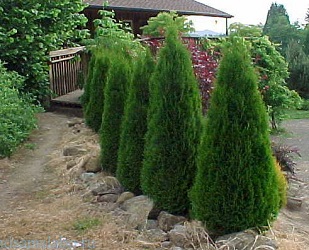
Among the evergreens ornamental shrubs- coniferous plants occupy the first place. They will decorate the site, play the role of a fence or border, they grow slowly, so they do not need frequent haircuts. Among coniferous shrubs, there are those that can withstand the scorching sun, and those that can grow in deep shade.
- juniper;
- yew berry;
- eastern biota;
- spruce prickly;
- cypress;
- fir.
All conifers tolerate winter well, but they do not tolerate excess water in the soil; this threatens to become infected with a fungal infection. On the other hand, coniferous shrubs cannot endure long dry periods: the soil under them needs to be moistened.
Coniferous shrubs not only grow much more slowly than deciduous ones, but also need careful pruning due to the nature of branching.
In landscape design, evergreen ornamental coniferous shrubs are used:
- the creation of hedges and borders (yew berry, thuja, juniper);
- separately growing plant;
- rockeries and alpine hills (creeping forms of juniper, spruce, cypress);
- compositions with flowers and deciduous shrubs;
- topiary - the creation of figures from plants (yew).
Some believe that conifers, having, as a rule, dark needles, lose deciduous shrubs in beauty. Indeed, in addition to beautiful leaves, these plants can boast of bright flowers and interesting fruits (for example, magonia, holly, cotoneaster). But breeders have bred varieties with multi-colored needles, variegated and bright, which compete with any decorative deciduous shrub.
Note: shrubs with variegated needles need good lighting, they should not be planted in the shade.
Attention! Only today!
Evergreen and wintergreen trees and shrubs are widely used in landscape gardening. They can brighten up your garden in winter, require little maintenance, and are rarely damaged by pests and diseases.
evergreens
A characteristic feature of evergreens - hairy or waxy leaves and a cork layer on the stems.
Unlike deciduous plants, evergreens do not change their foliage immediately, but gradually. Overwintered leaves or needles are replaced by new ones after a few years, although in winter green plants this occurs during the next growing season.
Almost all conifers are evergreen, although some species shed their needles for the winter. Among the evergreens and wintergreens, there are vines, tall trees, shrubs, creeping forms and ground cover species, for example, periwinkle, pachysandra, and hoof.
Evergreens are used for zoning the site and improving the microclimate. They also create a contrast with deciduous forms of plants, especially in winter.
Evergreens from the heather group, whose height varies from a few centimeters to several meters, can be combined with conifers. They are used in Japanese gardens, in semi-shady and sunny places.

Location selection

Many evergreens prefer places protected from the scorching sun and cold winds and non-drying soil.
In the right place, the plant will fully reveal its decorative qualities, give beautiful flowering and fruits.
Coniferous plants overwinter better if they are placed in groups, although some species, such as Scots pine, spruce and larch, normally tolerate wintering in open areas as a tapeworm.
These plants can be planted in last turn , after landing other ornamental trees and shrubs that will create a warmer and more sheltered microclimate.
It is also worth noting that plants of the same species relate differently to sunlight.
Planting Evergreens
All year round, with the exception of the period when the soil freezes heavily, you can plant plants grown in containers. Evergreens with an open root system should be kept for several hours in water or clay mash before planting. Plants with a clod of earth, wrapped in burlap, are well planted in the fall, they have time to take root until next spring.
Heather plants - rhododendrons, azaleas, heathers, ericas, Japanese pieris and kalmia - love well-drained acidic soil with a pH of 4.5-5, therefore, it is desirable to add high-moor sour peat to the planting pit. Pine prefers sand, and spruces grow better on clay soils.
The basic rule of landing - the root neck of conifers and heathers should not go deep, but be at the level of the soil. Therefore, these plants are planted on a prepared mound or root collar, when planted, they are left several centimeters above the soil level, given that the soil will sag. It is also necessary to monitor the location of the root neck of rhododendrons, after they have been unraveled in the spring.
Moisture requirements and overwintering
Evergreens for normal vegetation need enough available moisture, especially under bright sun, otherwise they will dry out.
This is especially true in the early spring and summer, when the conifers form young growths that must have time to mature and overwinter normally.
Successful wintering of evergreens depends on soil structure and mechanical composition. On heavy clay soils with poor aeration, which thaw for a very long time in spring, you need to constantly spray the crown of the conifers or shade them to avoid drying out the plants.

Shelter for the winter

Winter hardiness of evergreens depends on the biological characteristics of the species, growing conditions in nurseries and placement on the site.
For shelter use non-woven material, a special mesh, straw, spruce branches.
You can pre-install the frame or tie the branches to protect them from breakage.
At the beginning of winter, plants have high winter hardiness, and at the end of winter (February-March), they lose their resistance, especially young plants.
Before the onset of winter, especially if a very dry summer and autumn preceded it, it is important to water the plants well and plentifully and mulch the tree trunks. Mulching will protect the root system from freezing and reduce moisture evaporation.
evergreens
1. Common ivy (Hedera helix)
This shrub has green and variegated forms. It is quite hardy, but does not tolerate bright sunlight in the winter. In dark places, it may lose its variegation. It is used in landscape design for vertical gardening, usually on the north side of buildings.
2. Thuja western (Thuja occidentalis)
Needs fairly fertile and moist soil. It tolerates shearing and transplanting at a young age. It has a large number of decorative forms and colors of needles. Recommended for single, group and avenue plantings, as well as for creating "living" hedges and walls. Reaches a height of 10 m.
3. Nutkan cypress (Chamaecyparis nootkatensis)
The plant in adulthood is up to 15 m high, has a hanging top and hanging side shoots. Light and moisture-loving, does not tolerate stagnant waters. Withstands frosts down to -28 °C. Prefer fertile loamy and sandy soils. Used as solitaires.
4. Boxwood Evergreen (Buxus sempervirens)
Slow-growing shrub about 1 m high, with shiny leathery leaves. Prefers neutral and calcareous soils. Tolerates drought. Great for haircuts. It is used to form topiary forms and "living" hedges. If planted along the track with concrete base, it is necessary to separate the concrete with waterproofing or water the plant well.
5. Mahonia holly (Mahonia aquifolium)
Slow-growing shrub about 1 m high. Frost-resistant plant, tolerates partial shading. Sandy or loamy soil is most suitable, less dry and poor, grows in urban conditions. Planted in groups, make out "living" hedges and borders.
Green fences have attracted people for many centuries. They serve as a fence not only from prying eyes, but also from street dust. With proper care, a living wall will serve several generations of the family. Deciduous species look most striking, but in winter you will have to see gray trunks, so evergreens for hedges are ideal. Lianas, shrubs or conifers - the choice is extensive, but a number of nuances should be taken into account before planting.
Coniferous - a common and convenient choice
Before choosing which plants can be made from hedge, it is worth deciding on the optimal height of the future green fence. Coniferous and deciduous plants have their own height limit, which must be taken into account. Separate low borders, medium and high green walls. Conifers are suitable for any level, but grow slowly, so they buy mostly adult expensive specimens in containers. But you can grow them yourself with patience.
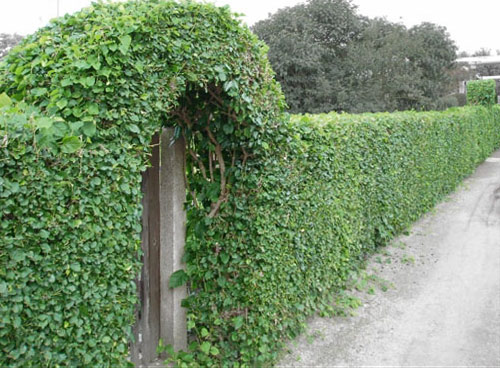
Reliable protection against road dust
Thuja - the leader for creating an evergreen wall
Thuja is the most common choice among the many hedge options. Of over a hundred species to obtain decorative fence only two fit:
- brabant - has a pronounced cone-shaped crown, in a separate plantation it grows up to 20 m, but in a fence - no more than 4 m. Annual growth up to 30 cm. Prefers good lighting, but will also grow in the shade. Planted at a distance of 70 cm from each other. Unpretentious, frost-resistant, but young thujas can suffer in the winter, so they need to be covered;
- smagard - does not have a pronounced conical shape, branches less. Annual growth is not more than 20 cm. For a dense wall, they are planted at a distance of 50 cm. He does not like to stay in the snow for a long time.
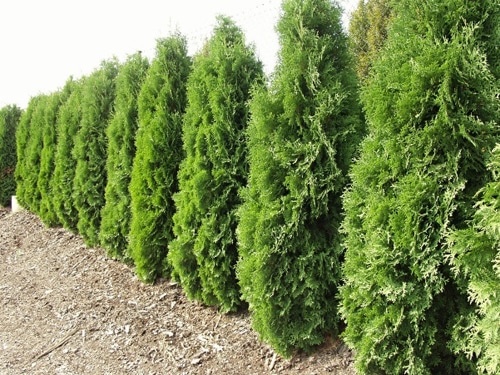
Thuja Brabant has a conical shape
The ends of the thuja branches should be cut a little, giving an even shape, but not too carried away, as it grows very slowly. Pruning can be done twice a year - in spring and autumn, but it is better not to touch the tops of young specimens.
Answering the question of how to water an evergreen thuja hedge, it should be noted that she does not like drought, but the roots will begin to rot from waterlogging. It is better to plant in the spring, after which water abundantly every other day, then once a week. Watering stops only for the winter period.
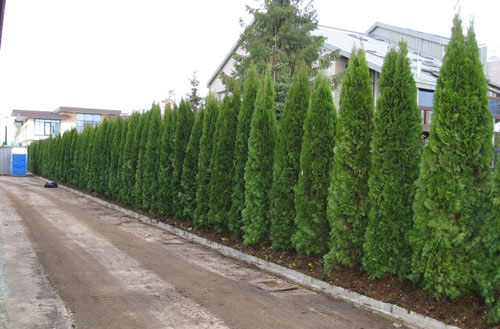
The smagard species branches less
Photos of the evergreen hedge confirm that such beauty is worth waiting for 8 years. It is during this period that the fence will become really impassable. Thuja, like many conifers, releases phytoncides into the air, known for its disinfecting properties.
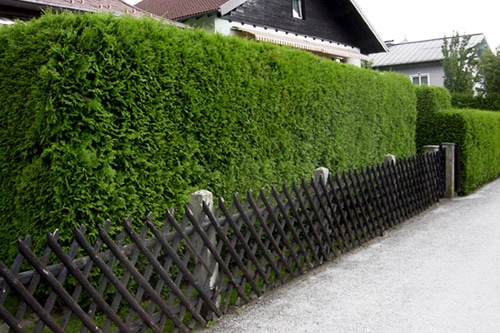
Such beauty can be expected
Juniper - shade-loving handsome man
If it is preferable to plant thuja in well-lit places, then shade is more suitable for juniper. You can grow an evergreen hedge only from cone-shaped forms, since sprawling ones are suitable for creating a low curb. It is important to choose male or female specimens for landing. This is necessary for a uniform look. Women's - wider, men's - narrower. The berries ripen in season 2-3.

Spreading forms are suitable for low borders
The height in the fence does not exceed 1.5 m, they are planted in a checkerboard pattern at a distance of 60 cm from each other. Drought tolerant but needs to be watered once a week. Photos of juniper hedge options clearly illustrate the wide variety of crown shades, as well as the shape and length of the needles.

Crown tint blue
Green bushes - spring at any time of the year
To create a dense wall that will enclose the site year-round, evergreen shrubs for hedges are suitable. If deciduous forms can boast of abundant flowering, then evergreen representatives attract with their unchanged appearance and decorative foliage. Individual plants still bloom, but usually rather inconspicuously. And there are exceptions.
Boxwood - easy to form and slow growing
Considering the types of shrubs for hedges, you cannot pass by boxwood. This is an ideal plant for creating green fences, but it also has its drawbacks. Attracts crown density, glossy small leaves, absolute unpretentiousness in terms of lighting, soil and watering. It is easy to grow a fence of the correct geometric shape from it.

Suitable for low curbs
The crown is pruned twice a year - in spring and autumn, but every six weeks, protruding from general view branches. Cut cuttings root easily, but boxwood grows extremely slowly. Significant shortcomings include:
- Thermophilicity. In cold regions it will grow low. Young seedlings cover.
- All parts of the plant are poisonous, so you should not opt for boxwood if there are small children in the family who can taste the leaves.

Easy to trim
Dense hedges are often found in the southern regions. The plant is planted at a distance of 60 cm from each other. To understand what kind of boxwood hedge is, it is better to refer to the examples in the photo, as this plant looks great both in low borders and in high fences.

Reaches a tall size
Calmia - enchants with beautiful flowers
Choosing which shrub to make a hedge, you can pick up not only an evergreen, but also a flowering plant. To create green fences, 3 types of kalmia are suitable:
- broad-leaved Kalmia - the most beautiful representative of the whole genus, reaches 3.5 m. It is grown in the southern regions, as it is very thermophilic. Attract beautiful inflorescences from dark pink to white shades;
- narrow-leaved kalmia - suitable for low green borders, since the height reaches no more than 1 meter, it is frost-resistant;
- Calmium is multi-leaved - reaches 1.5 m in height, frost-resistant. Blooms in late spring - early summer.

Blooming Calmia
Often this plant is chosen to produce a fast growing evergreen hedge. All species prefer partial shade, as direct sunlight burns the leaves. The soil loves fertile, loose, without stagnant water. For better growth and long flowering watered with fertilizers for rhododendrons.
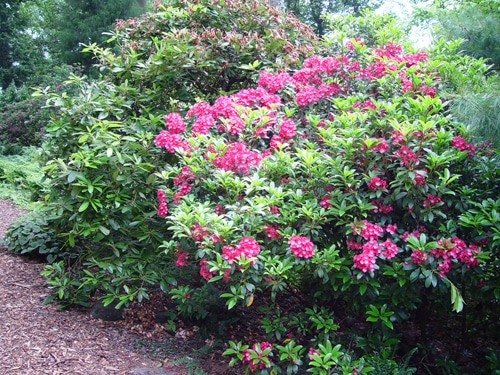
It is difficult to make a fence of the correct shape from it.
Fence of evergreen vines
Plantations of shrubs and trees do not necessarily need an additional fence, they independently create an impenetrable wall. For climbing plants, the presence of a support is important, which can be a capital brick fence or a lightweight mesh structure.
Ivy - unpretentious favorite
The easiest way to make a climbing evergreen hedge is to plant ivy. It is easy to find in any forest, so the option is also free. Decorative species with original color and shape of leaves are sold. All that is needed for successful growth is to land next to the support. Ivy climbs easily and grows quite quickly in the first year. This plant is unpretentious in the care and choice of soil. Watering is moderate, ivy is drought-resistant. It is not afraid of frost and looks the same at any time of the year.

And in winter appearance does not change
Honeysuckle - sophistication and decorativeness
In addition to ivy, you can find other evergreen vines for hedges. For example, one type of honeysuckle tolerates winter frosts well, which can damage young shoots, but this is not terrible for her. It grows quickly and reaches 6 m in length. Before growing an evergreen honeysuckle hedge, you should choose a place in partial shade. Unpretentious, drought-resistant. In summer, it blooms profusely with exquisite flowers. In autumn it will attract with decorative carved leaves.
![]()
Great when in bloom
Which evergreen hedge to plant on the site is an individual choice, but all the examples considered are suitable even for a novice gardener. A wall of fresh greenery cannot get bored, but if you want bright colors, you can place a low border of flowering shrubs next to a high fence.
Due to the varied color of the leaves and needles of evergreen trees and shrubs you can create interesting compositions in the garden.
evergreen conifers And deciduous trees and shrubs, which we have not paid attention to for some time, are now becoming fashionable again, they are planted to add variety to color scheme garden. Conifers, for example, have many different varieties of unusual coloration. They will be an ideal refuge for birds.
Yes, and among evergreen deciduous you can find varieties and species that attract our attention with their decorative leaves- shiny, with a white or yellowish border, like decorative forms of euonymus, sucker and many other woody ones.
Combinations with evergreen trees and shrubs
Multi-colored plants planted in front of it will help to revive a high green hedge. evergreens: juniper "Compressa" and ivy in pots; Fortune's euonymus; periwinkle and funkia (hosta) (hosta) as ground cover; weeping cypress pea; hybrid sucker, common holly; Chinese juniper. A red-leaved barberry interspersed with boxwood in a low hedge can complete the picture.
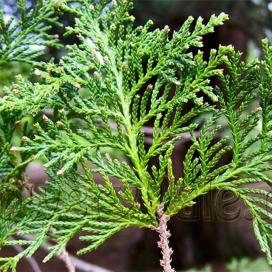

Prickly spruce is famous for its decorative silver-blue needles, which is why it is called blue spruce. A bright contrast is the blue dwarf spruce with the creeping yellow-leaved Fortune euonymus. Creeping euonymus can crawl up like ivy. The silvery border of its leaves stands out especially brightly against the background of dark tree trunks.
The holly has shiny dark green leaves with a yellowish-white border that color the tree and garden. all year round. In autumn, red berries will also be added, which birds love to feast on. Privet has been known for over 130 years. This shrub with yellowish oval leaves deserves a solo performance.
A variety of evergreens are good to plant in front of deciduous trees and shrubs. In summer, their restrained colors harmoniously merge into the overall color scheme, in autumn they create lovely contrasts, for example, with red foliage or red fruits of other plants, in winter, among bare trees, they generally become the main decoration of the garden.


Yellow, white and silvery leaves (especially needles) greatly enliven the dark corners of the garden. First of all, different varieties of evergreen creeping euonymus are suitable as ground cover here. To select taller plants, holly varieties that can grow in a shady place are suitable. Ivy and some varieties of euonymus, such as Emerald's Gold and Variegatus, will climb up the walls and supports. They are especially spectacular against the dark bark of tree trunks. Climbing onto a pergola or trellis, they form a good protection from the wind and prying eyes.
Variegated evergreens are suitable not only for mixed group plantings. They are no less interesting as soloists, especially if they differ in an unusual form of growth, for example, columnar or weeping. The color of a particular variety is often clear already from its name. For example, if the name contains the word "Aurea" or "Gold", we are talking about a yellow-colored variety, for blue varieties the word "Glauca" is characteristic, for variegated silver-green - "Varigata" and "Maculata".
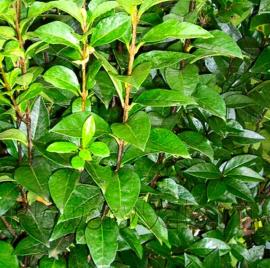
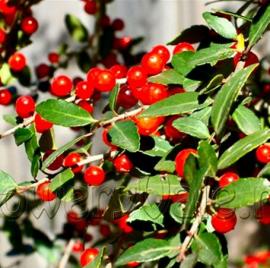
Landing and care
When allocating space in the garden for evergreen trees and shrubs, it should be borne in mind that they are more sensitive to winter cold than deciduous ones, so a place protected from northern and eastern winds is better suited for them. It is advisable to plant seedlings of trees with yellow needles in partial shade, if you plant them in an open sunny place, then you will have to take care of protection from the winds and the winter sun - the bright sun burns the needles, and they turn green in the shade.
The preferred time for planting is spring or autumn, then the plants take root quickly, if the seedlings are purchased with an earthen clod, then you can plant at any time. In winter, conifers and deciduous evergreens are shaded to reduce evaporation through the leaves. In autumn, they are well watered throughout the autumn, so that in winter their leaves or needles do not wither and dry out.
Pruning in the first years is not needed at all, with the exception of the shaped haircut, as well as the removal of dried twigs.
Landscape designers use for arranging the territory of private houses or parks. Photos with these can be seen on the pages of almost all specialized magazines on how to improve their own. To create a beautiful and well-groomed landscape, you need to know the rules for planting and caring for these representatives of the flora.
This article describes the popular ones for the garden, their names are given and photos are provided.
Blooms from autumn to mid-winter. It is recommended to plant in places well lit by the sun or slightly shaded. Propagated by lignified in autumn. In addition to aucuba, sun-loving plants are also: and An excellent solution for creating a side shadow with large beautiful foliage. Grows almost anywhere, but green shoots can be damaged by cold winter winds. It grows to a height of up to two meters, the leaves are green with characteristic yellow patches. 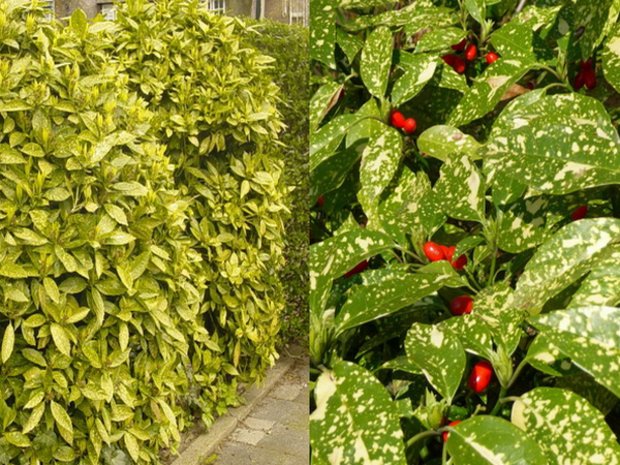
Important! Aucuba is not only beautiful, but also very poisonous. Moreover, the poison is found in all parts of the plant. Keep children away from him!
It is recommended to plant in places well lit by the sun or slightly shaded. For planting, plants are purchased in specialized stores.
It does not grow very quickly, closer to winter they appear similar to and without taste. The height of the most popular subspecies - large-fruited strawberries - can reach two meters. Has a white bloom, sometimes pink. 
It is recommended to plant in places well lit by the sun or slightly shaded. Propagated by cuttings planted in summer time under a glass canopy. Insensitive even to strong winds, gets along well in alkaline and dark places. Amenable to regular haircuts. The height of the main species - evergreen - can reach three meters if it is not cut. Some varieties have yellow blotches on the foliage, some have miniature sizes. 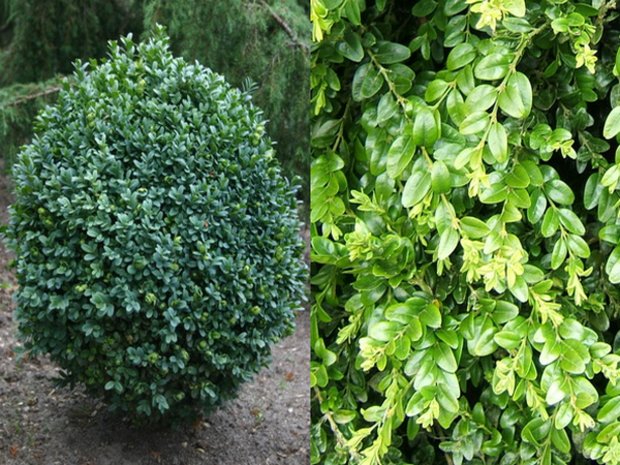
Blooms in the first two summer months. It is recommended to plant in places well lit by the sun. Propagated by cuttings planted in the summer under a glass canopy.
Flowering is small, stamens are issued in densely collected cylindrical inflorescences. Usually planted on the sun-facing side of the plot. Flowering is dark pink, the foliage is long. The height of the lemon-yellow callistemon can reach two meters, and the hard callistemon - only one and a half meters, but it is famous for its endurance. 
Blooms from mid-autumn to early winter. It is recommended to plant in places well lit by the sun or slightly shaded. Propagated by lignified cuttings in autumn.
The common holly grows to a height of up to three meters and is known as a symbol of Christmas. Some subspecies, despite the name, have non-spiky evergreen foliage. The so-called "Golden King" has yellow edges, while the "Silver Marginata" has white edges. The holly holly has leaves similar to boxwood.
Did you know?
The mention of the holly can be found in the bestseller of world literature- Harry Potter novels. According to the plot, Harry used a magic wand from this plant.

Camellia belong to tea evergreens, since its petals can be brewed and consumed in the form of drinks.
Gardeners appreciate it for its unimaginably beautiful flowering. That is why camellia is preferred by landscape designers. It creates an accent and attracts attention, perfectly complementing the site. It is possible to disperse the camellia in pots on the territory of the yard or in the house, and simple planting on the territory of the site. Planted both singly and in whole compositions. It is recommended to use large white pots similar to Chinese vases. 
Blooms from mid to late spring. It is recommended to plant in places well lit by the sun or slightly shaded. Propagated by cuttings planted in the summer under a glass canopy.
The peculiarity of this neat rounded shrub is a year-round dense leafy crown. The appearance of flat inflorescences occurs in the spring, and the aroma is emitted by both the blossoms themselves and the foliage. For the garden, it is recommended to use trifoliate choise, growing to a height of up to two meters. Some varieties are distinguished by yellow or narrow foliage. 
Blooms all summer. It is necessary to plant only in sunny places. Propagated by cuttings planted in the summer under a glass canopy.
Blooms are very fleeting with spots at the bases. These are characterized by the regular appearance of buds and constant flowering throughout the three summer months. Some varieties do not even reach one meter in height, like "Silver-Pink", others are taller, like "Purple".
Important!
If the summer turned out to be very hot, the cistus can shed all the foliage. To avoid this, it is recommended to produce additional watering.

The most popular shrub for our gardeners. It can fit perfectly into the composition of a landscape garden corner, it goes very well with other plants next to the lawn. Recommend the use of tree varieties for single plantations. Also, a budley is planted to disguise outbuildings, pipes, or both
The advantages are a variety of color palette of inflorescences, as well as their shape. It can be spherical, spike-shaped, sultan-shaped or in the form of panicles scattered along the stems. Nearby, you can plant bush plants as well, or use a budlea as a background for
Designers often make combinations with a transitional tone. A shrub can be given a spectacular look by cutting off the lower branches and placing it in flowerpots. 
It blooms from mid-summer to early autumn, sometimes until mid-summer. It grows to the height of an average tree, up to three to five meters. It blooms for no more than a dozen years, but when cultivated by cuttings, flowering can be obtained immediately, in the very first year. In view of this, it is more than an appropriate component for your site.
Did you know?
From Latin, the name Potentilla "Potentilla" is translated as "strength and power."The plant received it for its medicinal properties.

The plant is usually planted garden plots. Potentilla is defined by specialists as an unpretentious plant with pleasant foliage and bright flowers. Distinctive feature- fast growth and tolerance to emergence of shoots. With the planting of this shrub, the landscape becomes more structured and organic.
Potentilla can be placed:
- as a hedge (use as a border or frame Check out these evergreen shrubs: Shrubs are annuals and perennials, so their uses and difficulty in care vary. You can definitely say that they all decorate the place where they are located.
Functional purpose of shrubs is the most important criterion for choosing them when buying. Plants are upright and climbing, fragrant and odorless, flowering and deciduous, liana-like and ground cover. Based on this, their compatibility with other plantations is also taken into account. At the same time, shrubs can not only complement some crops, but also suppress various
Descriptions of plants and presented photographs will facilitate your study of a large assortment and features of shrubs, as well as orient you to right choice for your site.
Was this article helpful?
Not really



